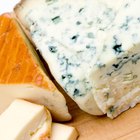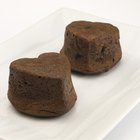
A well-made Brie cheese is a beautiful thing. The soft and creamy interior is rich and mild, with a complex and nuanced flavor. Baking the Brie makes it even creamier and richer-tasting, which makes it work well as a party dish or a private indulgence. Many recipes call for the Brie to be wrapped in puff pastry, adding carbs and pumping up the fat and calories even farther. If you're concerned about the carbs, or just saving a step, you can bake your Brie without a crust.
Brie Bakers
Many kitchen gadget manufacturers offer small ceramic or earthenware dishes specifically designed for baking Brie. Most are designed for the small, 8-ounce cheeses, though you can find larger ones if you shop around. To use your baker, preheat the oven to 350 degrees Fahrenheit. Unwrap the Brie, and very carefully slice off the top rind. Place the cheese in your baker, cut side up. Lining the bottom with a round of parchment paper speeds cleanup if your cheese bubbles over. Top the cheese with any optional ingredients, cover the dish, and bake for 30 to 35 minutes or until it's bubbly.
Other Dishes
Of course, you don't need a custom-made Brie baker to do the job. Any casserole or baking dish will do, or even a bowl if it's ceramic or heatproof glass. Prepare the Brie in the same way, carefully cutting off the top rind and setting it into the bowl or baking dish. These are usually deeper than a Brie baker, so getting one out without burning your fingers could be more problematic. It's easiest if you line the bottom with parchment, giving you the option of lifting out your Brie by the paper or simply sliding it, parchment and all, onto a cutting board.
The Niceties
You can top your Brie with a variety of of other ingredients to add flavors or visual appeal. Caramelized onions are one traditional choice, and dried fruits, toasted nuts or tart preserves are similarly appropriate. You also can spoon a sauce or chutney over the cheese after it's baked. That can be a good idea when you're serving company, because you don't have to worry about how your toppings will look when they come out of the oven. It's important to let the cheese rest for at least 10 to 15 minutes after it comes out of the oven, or up to 35 minutes for a large wheel. When it's freshly baked, the cheese is hot enough to cause a pretty good burn.
Alternative Wrappings
You can wrap the cheese in a coating that isn't pastry. For example, you might brush it with melted butter and form a crust by pressing crushed pecans or walnuts to the rind. Regular breadcrumbs or panko, applied the same way, can provide a contrasting texture without the calories -- or fuss -- of puff pastry. Wrap the cheese in grape leaves for a Mediterranean touch, or add flavor by wrapping it in large, fresh leaves of basil. With any of these techniques, you won't need to cut away the top rind.
Related Articles

Baking Brie With or Without the Rind

Can I Prepare Baked Brie Ahead of Time?

Do You Thaw Frozen Cheese Before ...

How Can I Get Brie to the Right ...

Types of Cheese Used in Pizza

Can You Substitute Mascarpone With ...

How to Crumble Gorgonzola Cheese

How to Cook a Prosciutto Panino
How to Pan-Fry Cheese
Easy Cheese Ball Recipe

How to Freeze Mascarpone

What Kind of Crackers Do I Serve With ...

Seasoning Ricotta Cheese for Lasagna

Cooking Pizza With Fresh Mozzarella

How to Make Homemade Flavored Cheese

How to Freeze Cheeses
Homemade Mozzarella Sticks with String ...

What Is a Souffle Dish?

How to Make Cannolis by Baking
Can I Substitute Neufchatel for Cream ...
References
Resources
Writer Bio
Fred Decker is a trained chef and certified food-safety trainer. Decker wrote for the Saint John, New Brunswick Telegraph-Journal, and has been published in Canada's Hospitality and Foodservice magazine. He's held positions selling computers, insurance and mutual funds, and was educated at Memorial University of Newfoundland and the Northern Alberta Institute of Technology.
Photo Credits
Polka Dot Images/Polka Dot/Getty Images